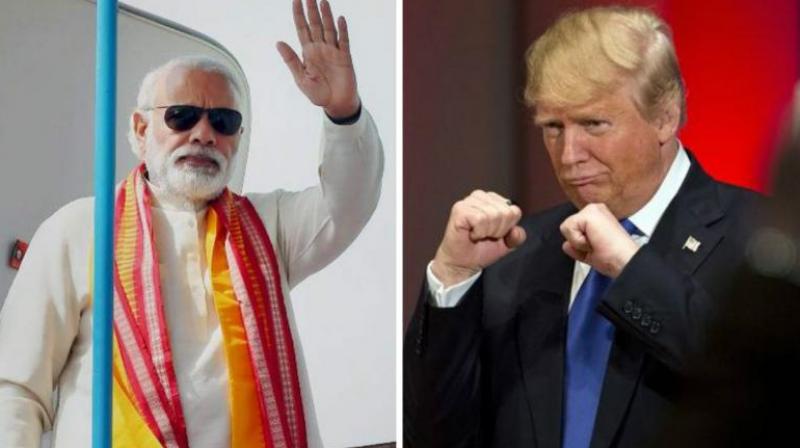As Modi & Trump meet, reset of ties on horizon?

Diplomacy locates convergence of interests between countries, minimises differences and eventually attempts to resolve conflicts. The 1972 Sino-US engagement or Sino-Indian thaw after Rajiv Gandhi’s 1989 tete-a-tete with Deng Xiaoping put differences on core issues aside for resolution later while expanding trade, investment and people-to-people exchanges. India’s relations with the United States have followed a different path as the 1998 Indian nuclear tests forced the US to confront a central issue: whether India was to be a mere friend with lingering differences or a partner crucial for global peace and security. Presidents George W. Bush and Barack Obama answered the last question clearly in the affirmative. The India-US nuclear agreement of 2008 was not merely about weaning India away from fossil fuels or climate change. It, as President Bush once put it while on a private visit to India after leaving office, was about unshackling India from the restraints of technology control regimes. For instance, it was not a coincidence that the Nuclear Suppliers Group, which India is still unable to join, was created immediately after India’s “peaceful” nuclear test of 1974. This US re-assessment of India was no doubt due to India’s economic success after liberalisation in the 1990s as indeed the twin challenges of the rise of radical Islam and China.
That consensus about India may no longer hold as President Donald Trump’s public statements and actions challenge that belief. He first questioned the “One-China” policy, the cornerstone of the Shanghai understanding reached between the US and China during President Richard Nixon’s China visit in 1972. President Ronald Reagan had similarly while campaigning berated that policy, but promptly sent his vice-president and old China hand George H.W. Bush (Bush Senior) to explain to the Chinese that US policy had not changed, although half-way through Mr Bush’s meeting with Deng Xiaoping a note was handed to the Chinese leader that Reagan had repeated the argument as they met. Mr Trump may not be Reagan, but he too backpedalled from his position. In addition, he announced US withdrawal from the Trans-Pacific Partnership of 12 nations aimed at creating a norm-based organisation that would force China to adapt or suffer by exclusion. The US withdrawal signifies an American retreat to China. Eventually, the Trump-Xi summit at Mr Trump’s Florida Mar-o-Laga estate, despite the US embarrassing Mr Xi by bombing a Syrian airbase as they dined, went off well. The Chinese promise of investment in the US created a semblance of understanding, sidelining Mr Trump’s charges of Chinese currency manipulation and tariff and non-tariff trade barriers. The President’s son-in-law, chaperoned by the Machiavellian Henry Kissinger, lubricated the process.
South Block is trying to downplay Prime Minister Narendra Modi’s visit to Washington, perhaps mindful of Mr Trump’s unpredictable nature. The Indian assumption that the United States perceives a strong and economically successful India as vital to balancing a rising and now assertive China may or may not be still valid. Once that is revalidated, the rest shall automatically flow from it. Thereafter, issues on which Mr Trump is unlikely to immediately compromise — like H-1B visas, which are linked to his electoral promises — can be separated from those that both can flaunt as successful takeaways. India has defence purchases as carrots and the US holds the technology transfer and co-production cards, about which India needs to be reassured. Mr Trump, unlike his predecessors, may not espouse UN Security Council reform. His intemperate and wrong remarks about India and China as beneficiaries of the climate change funding and the US as a victim need to be forcefully rejected. Mr Trump’s Riyadh summit on May 20 has already caused turbulence in the entire region to India’s west. The Shia-Sunni and Arab and non-Arab differences have been accentuated with the Saudi-UAE bloc pillorying Qatar. Iran and Turkey have rushed to Qatar’s aid while Kuwait and Oman have remained neutral, but the six-nation Gulf Coordination Council (GCC) is split down the middle. Mr Trump’s overturning President Obama’s carefully-built Iran outreach just when ISIS had been corralled and is being decimated defies logic. At the core of the GCC quarrel are Qatar’s relations with Iran.
The other issue of concern to India is Mr Trump’s gameplan for Afghanistan and his reading of terrorism, which he seems to view through a West Asian prism and not in global terms. He has authorised his generals to decide the timing and nature of the troop surge in Afghanistan. This has been criticised as illogical as clarity on strategy should have preceded it. India needs to warn that off and on suggestions that Mr Trump may favour peace-making between India and Pakistan on Kashmir, as he is attempting between the Israelis and Palestinians, will harm Indo-US relations. The Pakistani theory of the centrality of Kashmir to stabilising Afghanistan also needs to be effectively countered. Ironically, with Mr Obama’s Iran outreach, the pressure on India to isolate Iran had abated. This may return now as India works to counter China’s Belt and Road Initiative by pushing alternative connectivity schemes via Chabahar. India is caught between an assertive China and a disruptive Donald Trump. Unlike the Madison Square Garden mood in 2014, the diaspora is now defensive and even insecure with random attacks on Asians and their businesses. Mr Modi will hear from Mr Trump the same hollow words that his own government offers when asked about vigilantism in India by its right-wing adherents. Thus, strategic reaffirmation of the principle that a successful India is in the American interest would be a good starting point. Then proposals like shifting the F-16 fighter production line to India in exchange for India buying the outdated planes can follow. In lieu of a few hundred US jobs lost, their ancillaries will retain thousands. The big question is — can Mr Modi and Mr Trump resolve the contradiction between “America First” and “Make in India”?

